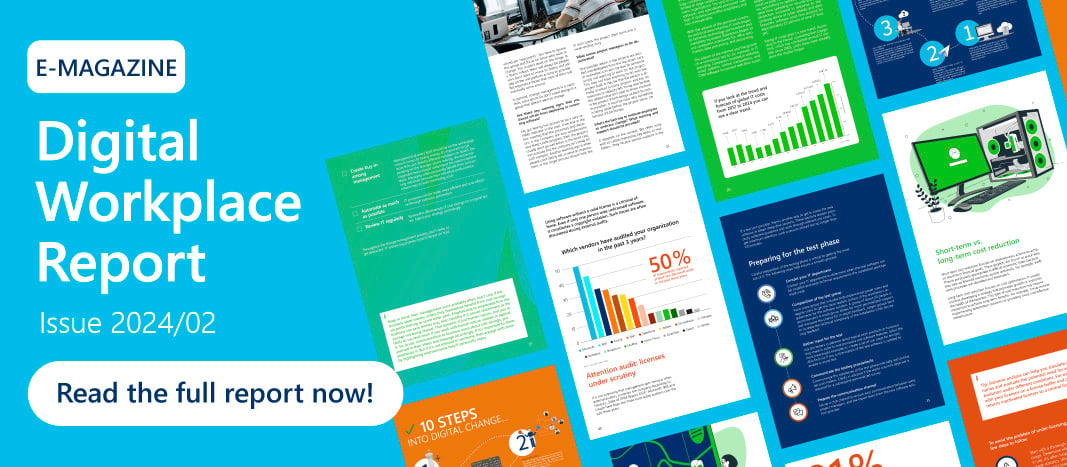Effective IT cost management: Strategies for difficult economic times
When the economy is facing significant challenges and competition is fierce in many industries, reducing IT costs is an important goal for organizations. Economic uncertainty has caused many organizations to rethink their spending and look for ways to reduce costs and use resources more efficiently.
At the same time, the increasing importance of digital technologies for business processes and innovation means that companies are more dependent than ever on their IT infrastructure and services.
Reducing IT costs isn’t just a short-term measure to alleviate financial pressures. In fact, it can be a long-term strategic advantage for businesses. By optimizing IT resources and processes, organizations increase efficiency, improve agility, and ultimately strengthen their competitive position. In addition, savings in IT costs enable companies to allocate financial resources to other important areas, such as research and development, marketing, or expanding customer service.
- IT costs - an increasing burden
- IT costs trend over time
- Components of IT costs
- Short-term vs. long-term cost reduction
- Tips for reducing IT costs
- What will happen in the future?
IT costs – an increasing burden
Despite the increased pressure to save, many companies are investing in their IT infrastructure. This may seem paradoxical, as there’s a conflict between saving and investing. However, it’s not as counter-intuitive as it may seem. An efficient and agile IT infrastructure is critical to long-term success and competitiveness.
Did you know that at the start of the COVID-19 pandemic, hardware prices increased by up to 20%? That was due to the sudden increase in demand for remote working. After a short time, however, prices normalized and have remained stable ever since.
The situation is different with software costs. They’ve risen almost everywhere in the wake of inflation. Microsoft, for example, raised prices for all its cloud services by 15 percent on April 1, 2023. SAP software also became 3.3 percent more expensive at the beginning of 2023.
Benefits of an efficient IT infrastructure
- Improve productivity
- Enhance competitiveness
- Drive innovation
- Ensure security and privacy
- Enable scalability
- Simplify compliance and governance
- Build business continuity and disaster recovery
 However, it’s not enough to blame inflation alone for rising IT costs. Several factors are driving this trend:
However, it’s not enough to blame inflation alone for rising IT costs. Several factors are driving this trend:
Technological progress
New technologies enhance or replace existing systems. While they may save money in the long run, these innovations often generate high upfront costs, whether due to the purchase of new hardware, the implementation of complex software solutions, or the training of employees.
Increased risk of security threats
The increasing number and sophistication of cyber-threats requires additional investment in security measures such as firewalls, anti-virus software, intrusion detection systems, and employee awareness training.
Data growth
As business processes become more digitized and larger amounts of data are collected, the need to store, secure, and process data increases.
Performance requirements
Increasing demands on the performance, availability, and reliability of IT systems may require organizations to invest in more powerful hardware, cloud services, or network infrastructure to meet these requirements.
Regulatory requirements
Organizations may need to invest in compliance and governance measures to meet government regulations and industry standards. This can result in additional costs for audits, privacy measures, and compliance tools.
IT cost trends over time
In the early years of information technology, computers and IT infrastructure were limited to large corporations and government organizations. The cost of hardware, software, and specialized personnel was high. IT systems were often proprietary and non-interoperable.
With the advent of the personal computer and local area networks, IT costs began to fall while technology performance and availability increased. Businesses began to use computers extensively for office automation, data processing, and accounting.
The advent of the Internet and the growth of e-commerce led to an increase in IT spending. Companies invested in websites, email systems, online transactions, and CRM software to connect with their customers and drive new business opportunities.
The shift of IT resources to the cloud and the increasing virtualization of infrastructure led to a change in IT costs. Enterprises began replacing traditional IT systems with cloud services, reducing capital expenditures, and shifting to operational costs. At the same time, spending on security and data protection increased in response to the growing threat of cyber-attacks and data breaches. Software costs now account for approximately 25 percent of total IT budget.
Rising IT costs aren’t a new trend. According to the French consulting firm Capgemini, which has conducted annual IT studies since 2003, costs have risen steadily since the studies began.
If you look at the trend and forecast of global IT costs from 2012 to 2024 you can see a clear trend.

The primary use of IT technologies has been to maximize business profits by making processes more efficient or automated. At present, AI technologies often supplement business processes and decisionmaking, for example to generate content ideas. However, as AI technologies continue to evolve, companies will be able to rely more on AI in their strategic planning and determine which tasks should be performed by AI and which by humans. That should lead to cost savings at some point in the future.
The same is true for government organizations, whose global IT spending is shown in the chart below. These organizations often have problems with legacy software that needs to be replaced due to a lack of efficiency or connectivity to other systems. In addition, customers expect government organizations to deliver a digital experience comparable to the private sector.

Components of IT costs
Many components contribute to an organization’s IT costs. They can be grouped into six categories:
Hardware:
- Computers and servers
- Networking devices (routers, firewalls, etc.)
- Storage devices (disks, SANs, etc.)
Software:
- Operating systems (e.g. Windows, macOS, etc.)
- Application software (e.g. ERP systems, CRM systems, etc.)
- Databases
- Security software (antivirus, intrusion detection and prevention systems, etc.)
Services:
- Salaries for IT staff
- External service providers (e.g. support, cloud services, etc.)
- IT consulting, if applicable
Infrastructure:
- Cloud services
- Data centers
- Network connectivity
- Power and cooling
Training and development:
- Employee training (education, certifications, continuing education)
- Software development (and maintenance), if applicable
Other:
- Licenses
- Compliance
- Data management
- Project management

Short-term vs. long-term cost reduction
Short-term cost reduction focuses on relatively easy actions to achieve short-term financial goals. These projects are known as quick wins. They’re particularly appropriate in difficult economic times because they free up financial resources quickly and easily. For example, inefficient processes are identified and eliminated.
Long-term cost reduction focuses on cost optimization. It usually involves developing a strategy that promotes growth or improves the health of the business. This type of cost reduction may require investment to achieve long-term benefits. For example, it may involve implementing automation solutions or providing more cost-effective infrastructure.
IT cost reduction: quick wins and long-term strategies
While the list of costs may seem overwhelming, there are several areas where savings can be made without compromising the efficiency or quality of IT services.
Quick wins
Let’s talk about quick wins, such as optimizing existing resources. Of course, maximizing hardware utilization by consolidating servers and storage devices will deliver immediate cost savings.
Review software licenses and manage them centrally to ensure that you pay for only the licenses you need and avoid over-licensing. For instance, request a downgrade of a service level agreement if you find that you haven’t ever needed a higher service level. Special license management software called software asset management (SAM) can help. These tools identify and inventory all programs used in the enterprise, highlight under- and over-licensing, and identify savings and optimization opportunities.
People use IT better when they know how. Communicate with users about the technologies you provide them. Regular messaging like “did-you-know…?” emails can help raise awareness about how they can take advantage of the technology they already have available. When people understand the technology they use, and how to use it correctly, efficiency improves, customers and clients get higher quality service, and employees enjoy improved job satisfaction.
Long-term strategies
Long-term strategies include standardizing and centralizing processes. Consistent, streamlined business processes reduce the likelihood of errors and inconsistencies. Also, standardized and centralized processes scale better. Procurement processes in particular benefit from economies of scale and more efficient use of resources. Controlled procurement prevents licenses or software from being purchased without the knowledge or approval of IT.
Consider migrating from on-premise IT resources to the cloud. That may reduce operational and capital costs. It takes a lot of planning, but it can save a lot of effort and money versus in-house IT.
Automate recurring IT tasks and processes to reduce human time needed elsewhere. Automation also minimizes errors. Detailed analysis is required to determine which processes can be automated. And digitization itself requires some resources.
Sometimes investments save money in the long run. One important (but often overlooked) example is investing in education and training of IT staff. Internal knowledgesharing programs and external certification opportunities build skills and minimize the need for expensive outside services.
Optimize energy efficiency to avoid unnecessarily high electricity costs. If you can, invest in renewable energy such as solar systems that allow you to generate your own electricity. The cost of purchase and installation is often recovered in just a few years.
Implement security solutions to minimize security risks. Potential data loss or breaches can cost a lot of money. Also, conduct regular security training for all employees to raise awareness of security risks.
Note: The best options are very individual and depend on the company’s goals and strategies. It’s best to coordinate all steps closely with the CEO.
Beyond the balance sheet: Other benefits of lower IT costs

Reducing IT costs is first and foremost about meeting the entire business’ goal of reducing costs. But other, less obvious advantages can help you make your case to the business.
- Lower IT costs often mean that products/ services can be offered to the market at more competitive prices, strengthening market positioning.
- With lower IT costs, more resources become available for innovation projects, allowing companies to research and develop new ideas.
- Efficient IT infrastructure reduces employee workload and increases productivity, which in turn increases employee satisfaction and loyalty.
- Companies with lower operating costs are often more attractive to investors because they can offer better returns and longterm stability.
Checklist: Tips for reducing IT costs
Develop a strategy
Before you cut IT costs indiscriminately, develop a strategy. What are your current costs? What are your goals? Do you have a specific idea of how much you want to save?
Analyze the existing cost structure
What hardware and software does the company have? What’s being used efficiently? What needs to be optimized? Assess the entire IT landscape. Changes don’t always have to be accompanied by restrictions for employees.
Identify quick wins
They allow you to show that you’re making a real difference to the business. This motivates your colleagues and influences buy-in. Importantly, quick wins create a basis for negotiations with your CEO.
Consider software asset management (SAM)
Especially in larger companies, software licensing can get very confusing. The cost of a SAM is money well spent when compared to the cost of related staffing. If necessary, you can renegotiate your contracts based on insights gained from SAM.
Don’t shy away from short-term investments
Even if purchasing a software asset management system or investing in a solar system costs more up front, it’ll pay off in the long run. Saving money in the short term rarely works.
Create buy-in among end users
Put yourself in your users’ shoes. Analyze how people in your organization actually do their jobs before making any IT changes that affect their work. People will more likely accept change if it makes their lives easier in some way. But don’t proceed on mere assumptions. Go out and interview people in the business; ask selected users to show you what they do and how they do it; find out where their pain points are and how you might relieve them. An added advantage of outreach to users: by establishing relationships with “power users”, an IT team forges alliances that will help cultivate buy-in across the organization.
Create buy-in among management
Management at every level should be on the same page when it comes to saving money. It’s important to get more than just directly affected managers on board. Depending on the changes you‘re making, the entire management team should understand the reasons behind them. Managers often personally benefit from cost-saving initiatives because their individual performance criteria may include minimizing costs.
Automate as much as possible
IT processes can be made more efficient and cost-effective through extensive automation.
Review IT regularly
Review the effectiveness of cost savings on a regular basis. Adjust your strategy accordingly.
Throughout the change management process, don’t delay or get distracted. IT-enhancing projects must not be put on hold.
Keep in mind: Non-management employees often don’t care about the company saving money unless they directly benefit from it, such as through profit sharing or other perks. Focusing on cost savings might even backfire if it leads to resentment over those savings not being shared. That’s just human nature, and you’re more likely to succeed by working with it rather than against it. So, when communicating with employees about cost savings, consider their perspective. If it matters to them, emphasize it. But if it’s not relevant, focus on improvements they’ll personally benefit from.
What will happen in the future?
IT spend is expected to continue to rise as new technologies such as AI, machine learning, the Internet of Things (IoT), and blockchain gain traction. According to a study by Capgemini, the main goal of companies and government agencies is to maintain and modernize systems.
In addition to increasing agility, a key priority must be to improve system security. Cyber-attacks are an ever-increasing threat that cuts across all industries.
Companies will continue to invest in modernizing their IT infrastructure to remain competitive and meet changing customer and market demands. At the same time, they’ll strive to manage their spending efficiently and get the most out of their IT investments. Short-term savings and quick wins generate momentum and good will at minimal cost. However, long-term savings and sustainable improvements often require investment.
It’s possible that the use of AI will also lead to cost reductions in the long term, but it’s currently difficult to predict when this will happen. Capgemini’s IT study also shows that AI already has a wide range of applications that’ll continue to grow in the future. Depending on the application, the use of AI could increase by up to 175% in the next two years.
And of course, new technologies will continue to appear. Take advantage of them!
You May Also Like
Related articles

Early software mistakes and the “told you so” effect

Cutting costs isn't enough to drive change - change needs story


